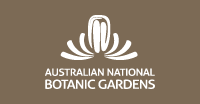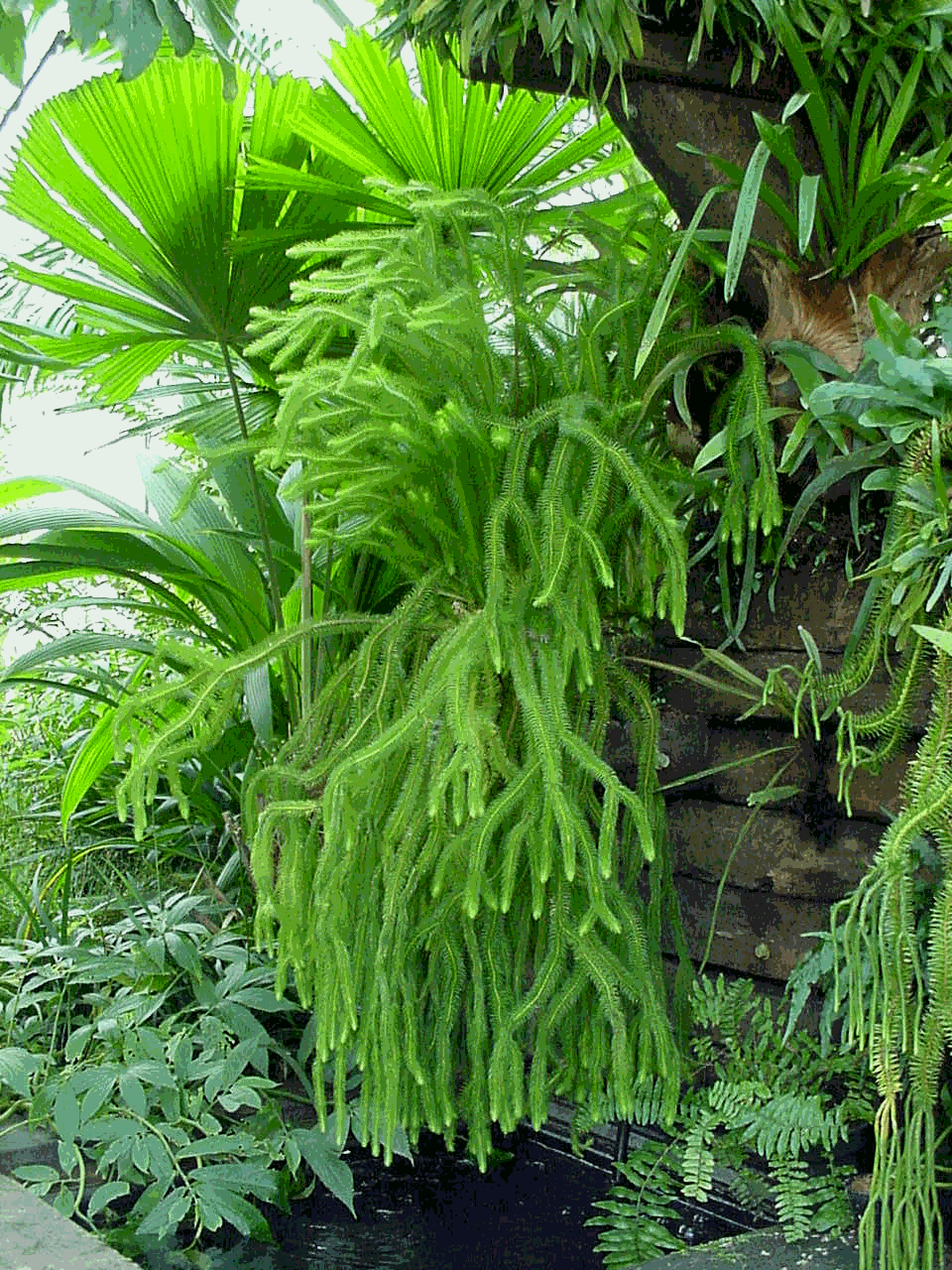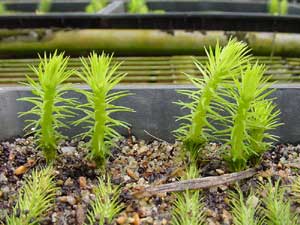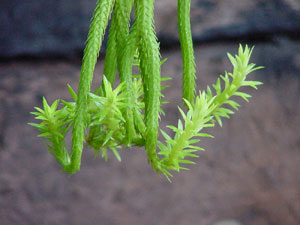Growing Tassel Ferns and Clubmosses
by Joe McAuliffe
Tassel ferns and Clubmosses are a group of fern allies, which, via fossils date back to the Carboniferous period. They belong to the family Lycopodiaceae which is divided up into four genera.
Lycopodium - Terrestrial, surface creeping or climbing plants. A genus of c. 40 species widespread in temperate and tropical regions. 4 species (L. scariosum, L. fastigatum, L. volubile, and L. deuterodensum) occur in Australia.
Lycopodiella - Terrestrial, creeping plants. A genus of c. 40 species widespread in moist-temperate and tropical regions of the world, but especially diverse in the Americas. 5 species (L. cernua, L. limosa, L. serpentina, L. diffusa and L. lateralis) occur in Australia.
Phylloglossum - Small terrestrial plants with a subterranean tuber. A monotypic genus endemic to southern Australia and New Zealand. 1 species (P. drummondii) occurs in Australia.
Huperzia - Lithophytic or epiphytic plants. A genus of more than 200 species occurring from the tropics to the Artic and Subantarctic zones, and from sea-level to alpine environments. 12 species (H. filiformis, H. serrata, H. australiana, H. dalhousieana, H. squarrosa, H. marsupiiformis, H. varia, H. phlegmaria, H. phlegmarioides, H. lockyeri, H. carinata and H. prolifera) occur in Australia.
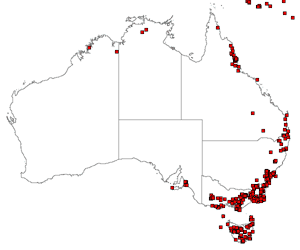 Lycopodium |
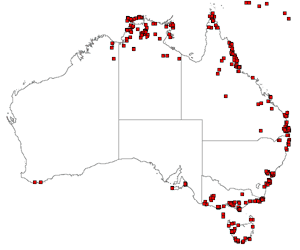 Lycopodiella |
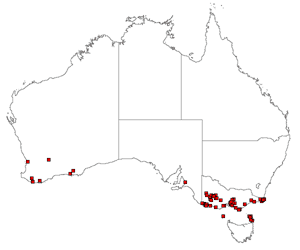 Phylloglossum |
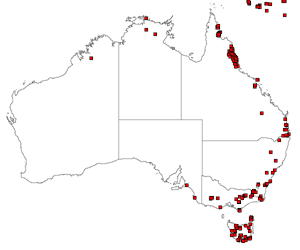 Huperzia |
The family Lycopodiaceae comprises terrestrial species and a unique group of epiphytes commonly referred to as Tassel Ferns. The terrestrial group grows in a variety of situations including moist infertile soils in and around swamps and depressions. Some form scrambling colonies on earth banks and others are found in alpine and sub-alpine environments.
|
The epiphytic group are usually found growing on plants (epiphytic), rocks (lithophytic) and occasionally found growing in terrestrial habitats. They are typically found growing in moist forests and rainforests at high altitudes in and amongst mosses and other epiphytes.
Terrestrial Group Cultivation.
Genera: Lycopodium, Lycopodiella and Phylloglossum.
Most terrestrial species generally resent root-zone disturbance. They are typically slow to establish and prove to be difficult to maintain for any length of time in cultivation. Some of the difficult species include Lycopodium deuterodensum, Lycopodium scariosum and Lycopodiella limosa. These plants grow with a mycorrhizal association, which is difficult to simulate. Being such a diverse group they are varied in their soil requirements. Most species tend to prefer well drained, slightly acidic soils. This can be adapted to the potting media and either soil based or non-soil-based media can be used. Typical potting media ingredients including composted pine bark of various grades and treatments, sandy loams, peat moss or peat moss substitutes such as coir (coconut fibre), coarse sand, gravels of various descriptions and propagation media's such as perlite and vermiculite can be used. Generally plants respond well to their natural soil or one of a similar structure being used as the major component of the media. Species specific factors such as soil moisture levels and natural rainfall should influence other media ingredients eg. Species occurring in swamp margins will require a potting media with a greater degree of water holding capacity than species found in seasonally dry heath.
Plants generally require a constant source of water and many growers use saucers under the pots to prevent plants from drying-out. Low nutrient levels are typical in their natural environment and this should reflect in the choice of potting media and fertilisers. Usually no fertilisers are added to the potting mixes but the use of well-rotted cow manure is sometimes beneficial. Plants will benefit from periodic liquid fertilising with fish emulsion or seaweed extracts at low rates. A high to moderate light level is preferred. Plants can withstand scorching sun and hot conditions if established. Young plants should go though a hardening process before being subjected to extreme conditions. Weak plants are often infested with scale. Other pests include snails, slugs and earwigs.
Terrestrial plants can often be divided. However, plants generally resent disturbance and once established should not be disturbed. Tip layering and cuttings can reproduce some creeping species (such as Lycopodiella cernua).
Epiphytic Group Cultivation
Genus: Huperzia.
Tassel Ferns are relatively easy to grow, make attractive specimen plants and the hardier varieties can be used in a wide range of situations and growing conditions.
Tassel Ferns grow well in coarse epiphytic potting mix. It should be well drained, provide plenty of aeration and have good moisture holding capacity. Materials such as Sphagnum moss, coir (coconut fibre), osmunda (tree fern) fibre, pine bark, red gum chips, charcoal, Oasis®, cork and scoria can be combined in different ways to produce suitable growing media. Ingredients which a prone to rapid decomposition should be used sparingly. Old mixes with peat and sphagnum moss components become too fine and soggy and will either require regular replacement or the hand of a careful waterer. Air pockets, created by large, coarse particles in the mix attract prolific root growth.
Many Tassel Ferns are grown in stunning hanging basket displays. Some grower’s report stem damage from galvanised wire. To avoid this, plastic coated wire can be used. With time, some plants become large and quite heavy, care should be taken when selecting hanging materials and points.
Tassel Ferns enjoy plenty of water. In warm conditions they should be watered daily. In Temperate regions such as Canberra, they are usually grown in greenhouses but can be grown in a variety of other situations. The Australian National Botanic Gardens has been able to grow Tassel Ferns in outside conditions throughout the year, provided plants are given adequate frost protection. In cooler climates it’s important to reduce watering frequency during winter. This will help avoid the occurrence of stem and leaf rot. Weak liquid fertiliser solutions such as fish emulsion and seaweed extracts applied at regular intervals are particularly useful.
Tassel Ferns require good light for growth but must be protected from full sun. Plants grown very bright light often take on a bleached appearance, additional shade should be provided to plants that take on this appearance. Humidity is important and plants should be placed according to their particular needs. Free and unimpeded air movement is vital. Stuffy conditions are very quickly fatal to Tassel Ferns and is often associated with pest attack. Common pest attacks are almost always by scale insects, in particular fern scale. Infestations cause yellowing of the tissues and can result in the death of stems or the entire plant. Snails and slugs often eat the tips of young shoots.
|
A variety of propagation techniques can be used including tissue culture, division, aerial growth, layering, cuttings and stem propagation (further discussed).
Stem Propagation
Some epiphytic Tassel Ferns and a few terrestrial species can be propagated by a technique which is termed stem propagation. It is a modified cutting/layering technique invaluable in the propagation of a number of species. Apical sections of 5 – 15cm (2 – 6 inches) long are removed from the stock plant and laid horizontally on top of a typical propagation media. Both ends of the cutting are covered with media, leaving the middle of the stem exposed. These are kept moist, humid and warm (some growers use aquariums or terrariums). After a period of 6 – 15 months the apical growth emerges from the cutting mix.
The young plants should be left undisturbed until they grow to approx. 5cm (2 inches) high or more before carefully potting into a suitable epiphytic mix. Numerous basal shoots may soon follow. Recently potted plants should be allowed to establish before further disturbance or being removed from optimum growing conditions. Production turnover varies with species but small marketable plants are obtainable within 1 – 2 years from propagation. Obtaining large specimens will require several years of care but are well worth the effort.
References
Jones, D L, Encyclopaedia of ferns : an introduction to ferns, their structure, biology, economic importance, cultivation and propagation, Port Melbourne : Lothian, 1987.
Flora of Australia. Volume 48, Ferns, gymnosperms and allied groups.
Canberra : Australian Biological Resources Study, CSIRO Australia, 1998.
![An Australian Government Initiative [logo]](/images/austgovt_brown_90px.gif)





